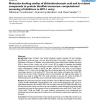Free Online Productivity Tools
i2Speak
i2Symbol
i2OCR
iTex2Img
iWeb2Print
iWeb2Shot
i2Type
iPdf2Split
iPdf2Merge
i2Bopomofo
i2Arabic
i2Style
i2Image
i2PDF
iLatex2Rtf
Sci2ools
BMCBI
2008
2008
Molecular docking studies of dithionitrobenzoic acid and its related compounds to protein disulfide isomerase: computational scr
Background: Entry of HIV-1 into human lymphoid requires activities of viral envelope glycoproteins gp120 and gp41, and two host-cell proteins, the primary receptor CD4 and a chemokine co-receptor. In addition, a third cell-surface protein called protein disulfide isomerase (PDI) is found to play a major role in HIV-1 entry. PDI is capable of mediating thio-disulfide interchange reactions and could enable the reduction of gp120 disulfide bonds, which triggers the major conformational changes in gp120 and gp41 required for virus entry. In this scenario, inhibition of HIV-1 entry can be brought about by introducing agents that can block thiol-disulfide interchange reaction of cell surface PDI. There have been studies with agents that inhibit PDI activity, but the exact mode of binding remains to be elucidated; this might provide insights to develop new drugs to target PDI. This study attempts to perceive the mode of binding of dithionitrobenzoic acid (DTNB), and its structurally related ...
| Added | 09 Dec 2010 |
| Updated | 09 Dec 2010 |
| Type | Journal |
| Year | 2008 |
| Where | BMCBI |
| Authors | Uthaman Gowthaman, Mannu Jayakanthan, Durai Sundar |
Comments (0)

